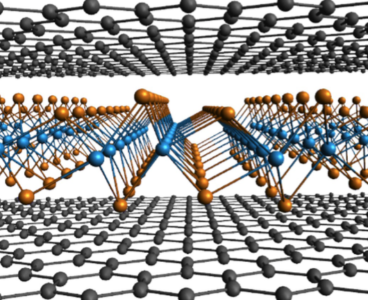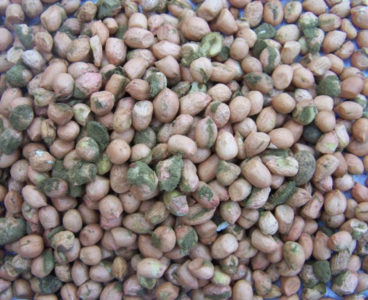At the chemical level, diamonds are no more than carbon atoms aligned in a precise, three-dimensional (3D) crystal lattice. However, even a seemingly flawless diamond contains defects: spots in that lattice where a carbon atom is missing or has been replaced by something else. Some of these defects are highly desirable; they trap individual electrons…
Room Temperature, 2D Platform Advances Quantum Technology
Quantum computers promise to be a revolutionary technology because their elementary building blocks, qubits, can hold more information than the binary, 0-or-1 bits of classical computers. But to harness this capability, hardware must be developed that can access, measure and manipulate individual quantum states. Researchers at the University of Pennsylvania’s School of Engineering and Applied…
Penn Engineer’s ‘Metallic Wood’ has the Strength of Titanium and the Density of Water
High-performance golf clubs and airplane wings are made out of titanium, which is as strong as steel but about twice as light. These properties depend on the way a metal’s atoms are stacked, but random defects that arise in the manufacturing process mean that these materials are only a fraction as strong as they could…
Penn Engineers 3D Print Smart Objects with ‘Embodied Logic’
Penn Engineers Develop Ultrathin, Ultralight ‘Nanocardboard’
When choosing materials to make something, trade-offs need to be made between a host of properties, such as thickness, stiffness and weight. Depending on the application in question, finding just the right balance is the difference between success and failure Now, a team of Penn Engineers has demonstrated a new material they call “nanocardboard,” an…
Class of Neurological Disorders Share 3D Genome Folding Pattern
In a class of roughly 30 neurological disorders that includes ALS, Huntington’s Disease and Fragile X Syndrome, the relevant mutant gene features sections of repeating base pair sequences known as short tandem repeats, or STRs. Healthy people have STRs of normal lengths distributed across their DNA. For people with trinucleotide repeat (TNR) expansion diseases, however,…
Paving the Way for Safer, Smaller Batteries and Fuel Cells
Fuel cells and batteries provide electricity by generating and coaxing positively charged ions from a positive to a negative terminal which frees negatively charged electrons to power cellphones, cars, satellites, or whatever else they are connected to. A critical part of these devices is the barrier between these terminals, which must be separated for electricity…
Penn Engineer Make Drug Microparticles a Thousand Times Faster Than Ever Before
Pharmaceuticals owe their effects mostly to their chemical composition, but the packaging of these drugs into specific physical formulations also need to be done to exact specifications. For example, many drugs are encapsulated in solid microparticles, the size and shape of which determine the timing of the drug’s release and its delivery to specific parts…
False Beliefs About MMR Vaccine Found to Influence Acceptance of Zika Vaccine
People’s willingness to use a Zika vaccine when it’s available will be influenced by how they weigh the risks associated with the disease and the vaccine, but also by their misconceptions about other vaccines, a new study has found. While a Zika vaccine is in development, the study by researchers at the Annenberg Public Policy…
Penn Engineering Research Gives Optical Switches the ‘Contrast’ of Electronic Transistors
Current computer systems represent bits of information, the 1’s and 0’s of binary code, with electricity. Circuit elements, such as transistors, operate on these electric signals, producing outputs that are dependent on their inputs. As fast and powerful as computers have become, Ritesh Agarwal, professor in the Department of Materials Science and Engineering in the…
Researchers use WWII Code-Breaking Techniques to Interpret Brain Data
Researchers Demonstrate how to Control Liquid Crystal Patterns
When Lisa Tran set out to investigate patterns in liquid crystals, she didn’t know what to expect. When she first looked through the microscope, she saw dancing iridescent spheres with fingerprint-like patterns etched into them that spiraled and flattened as the solution they were floated in changed. The sight was so beautiful that Tran, a…
Engineers Develop Filters That Use Nanoparticles to Prevent Slime Build-up
Filtration membranes are, at their core, sponge-like materials that have micro- or nanoscopically small pores. Unwanted chemicals, bacteria and even viruses are physically blocked by the maze of mesh, but liquids like water can make it through. The current standard for making these filters is relatively straightforward, but doesn’t allow for much in the way…
Melanoma Cells Rewire to Resist Drug Treatment
In 2014, new combination therapies to treat patients with metastatic melanoma hit the market, helping extend the lives of those with this aggressive disease. Yet unfortunately, after several months of treatment, almost all patients on the regimen eventually relapsed. A study out this week in Nature, led by scientists from the University of Pennsylvania and The…
New Method Could Enable More Stable and Scalable Quantum Computing
Engineers Develop First Transistors Made Entirely of Nanocrystal ‘Inks’
The transistor is the most fundamental building block of electronics, used to build circuits capable of amplifying electrical signals or switching them between the 0s and 1s at the heart of digital computation. Transistor fabrication is a highly complex process, however, requiring high-temperature, high-vacuum equipment. Now, University of Pennsylvania engineers have shown a new approach…
Engineers Overcome a Hurdle in Growing a Revolutionary Optical Metamaterial
Versatile 2-D Material Grown With Topological Electronic States
University of Pennsylvania researchers are now among the first to produce a single, three-atom-thick layer of a unique two-dimensional material called tungsten ditelluride. Their findings have been published in 2-D Materials. Unlike other two-dimensional materials, scientists believe tungsten ditelluride has what are called topological electronic states. This means that it can have many different properties not…
Linking Human Genome Sequences to Health Data Will Change Clinical Medicine
Engineers Make Nanoscale ‘Muscles’ Powered by DNA
The base pairs found in DNA are key to its ability to store protein-coding information, but they also give the molecule useful structural properties. Getting two complementary strands of DNA to zip up into a double helix can serve as the basis of intricate physical mechanisms that can push and pull molecular-scale devices. Engineers at…
Anti-Inflammatory Drugs Could Strengthen Airway Immunity to Fight Infections
Toxins from mold found growing on nuts or corn can weaken the airways’ self-clearing mechanisms and immunity, opening the door for respiratory diseases and exacerbating existing ones, suggests a study in Nature Scientific Reports published this month from otolaryngology researchers at thePerelman School of Medicine at the University of Pennsylvania. Poisonous and cancer-causing, aflatoxins are a type of…
Scientists Improve Computer Modeling for Designing Drug-Delivery Nanocarriers
A team of University of Pennsylvania researchers has developed a computer model that will aid in the design of nanocarriers, microscopic structures used to guide drugs to their targets in the body. The model better accounts for how the surfaces of different types of cells undulate due to thermal fluctuations, informing features of the nanocarriers…
Researchers Use Nanoparticles to Break up Plaque, Prevent Cavities
Chemists Establish Fundamentals of Ferroelectric Materials
Ferromagnetic materials, like compass needles, are useful because their magnetic polarization makes them rotate to align with magnetic fields. Ferroelectric materials behave in a similar way but with electric, rather than magnetic, fields. That external electric fields can reorient the electric polarization of these materials makes them ideal for certain memory applications, such as stored-value…






















